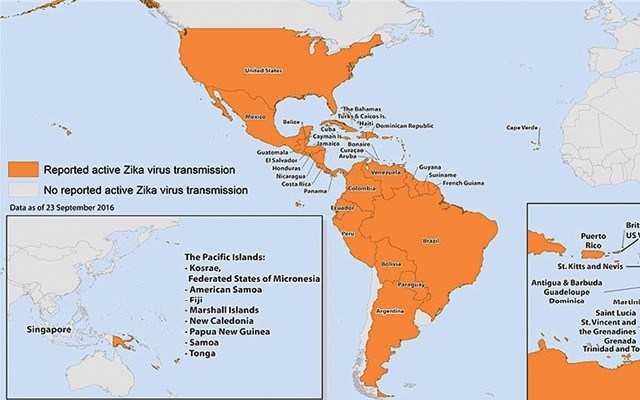It's fall, and many Whistlerites are travelling south — Mexico, Panama, Nicaragua. Nothing unusual there. But what is a little strange is that many folks don't seem to know much about Zika, an emergent disease of which they should be very concerned — particularly given the amount of baby-farming going on in the Sea to Sky corridor. So consider this a public service announcement.
Zika virus (ZIKV) is a flavivirus (like Dengue) spread by day-active Aedes mosquitoes, such as the yellow fever mosquito, A. aegypti, and the Asian tiger mosquito A. albopictus, which have been moved from their original homes in Africa and Asia to tropical and sub-tropical environments around the globe. Discovered during routine screening of monkeys for yellow fever in Uganda's Zika forest in 1948, the first human case of Zika wasn't reported until 1952, and its slow movement out of Africa closely followed the spread of competent mosquito vectors — Pakistan and southeast Asia in the 1970s, big outbreaks on Pacific Islands into the new millennium. Because Aedes mosquitoes are now distributed worldwide, it was inevitable ZIKV would reach new regions. Already, cases were being reported among returning travellers in the U.S. when an epidemiologist friend, Dr. Issac I. Bogoch, thought to model potential outbreaks of the disease based on climate change, the spread of mosquito vectors, and air travel patterns.
"Lots of people got sick on the Pacific Islands, but like chikungunya (another emergent disease recently epidemic in the tropical Americas), Zika seemed mild and self-limiting, so no one really cared about it. But I suspected it would go to South America because they had the right mosquito vectors and climate conditions and, like chikungunya, the only thing required for it to take off was one viremic person to step off a plane in the right spot," he told me back in August 2015.
"So we start modelling this, and boom — in May 2015, around 40 cases are reported in northeast Brazil and we think, 'Here comes the storm — this is going to be bad.' Because if you can make a single diagnosis, there's likely many more cases — and we suspected thousands more. Meaning this was a big deal public health officials needed to know about," he summed up.
The researchers developed a colour-coded map of South America showing areas of potential year-round transmission, seasonal transmission, and no transmission. Sadly, few paid attention.
Disease has changed the course of human history, and you need look no further for an example of why modelling is important to public health than how the Zika story played out: In December 2015, spikes in the birth defect microcephaly and the immuno-neurological disorder Guillain-Barré syndrome in Brazil were alternately linked to ZIKV and pesticides being covertly used to dampen mosquito vectors; the former proved to be the culprit, the latter, only spurious correlation. By January 2016, ZIKV was confirmed in Puerto Rico (now some 30,000 cases); by spring there was mosquito-human transmission in Florida, and a new twist — sexual transmission of the virus. The World Health Organization called Zika's spread "explosive" and by February declared an international emergency. The Brazilian epidemic spiraled into summer and fear of the contagion — particularly by those who were, or planning to become, pregnant — seriously impacted tourism and the 2016 Summer Olympic Games in Rio de Janeiro. With Zika raging in some 50 countries in the Americas, millions are now infected, including tens of thousands of pregnant women. With over 4,000 cases in the continental United States, late summer saw an outbreak in Miami Beach; panicking, South Carolina began aerial spraying for Aedes mosquitoes, inadvertently killing billions of other insects, including honeybees.
The virus's true latent extent and spread perfectly mirrored the predictions of the model Bogoch showed me a full year earlier.
Many infected with ZIKV don't get sick. Those who do develop symptoms — fever, rash, joint pain, red eye — usually see them last several days to a week. But Guillain-Barré syndrome, a rare disorder causing temporary muscle weakness and paralysis, is strongly associated with Zika. And microcephalic children have now been born to returning travellers in Western nations — including Canada. As with chikungunya, there is no vaccine to prevent Zika, no medicine to treat it, so the question is, what can travellers do?
First, get informed (http://wwwnc.cdc.gov/travel/page/zika-travel-information). And if you insist on travelling to a Zika-affected country, protect yourself by preventing mosquito bites: cover exposed skin; use insect repellents containing DEET or other strong compounds; stay in places with air conditioning and window and door screens; sleep under a mosquito net.
There are also post-travel precautions. Though not an issue in Whistler right now, you must take steps to prevent mosquito bites for three weeks after your trip, even if you don't feel sick, so you don't pass Zika to uninfected mosquitoes that can spread the virus to others. If you're thinking about pregnancy, talk with a doctor to see how long to wait before attempting this, and, because any kind of sex can spread Zika, in any event you must use condoms after travel to protect sexual partners.
Leslie Anthony is a Whistler-based author, editor, biologist and bon vivant who has never met a mountain he didn't like.




